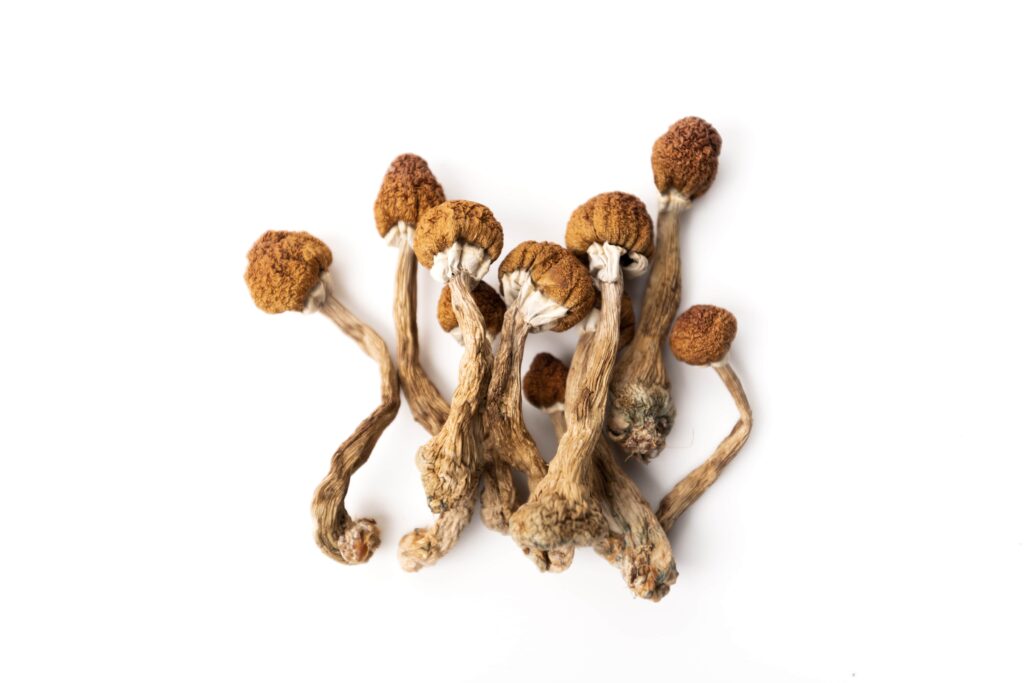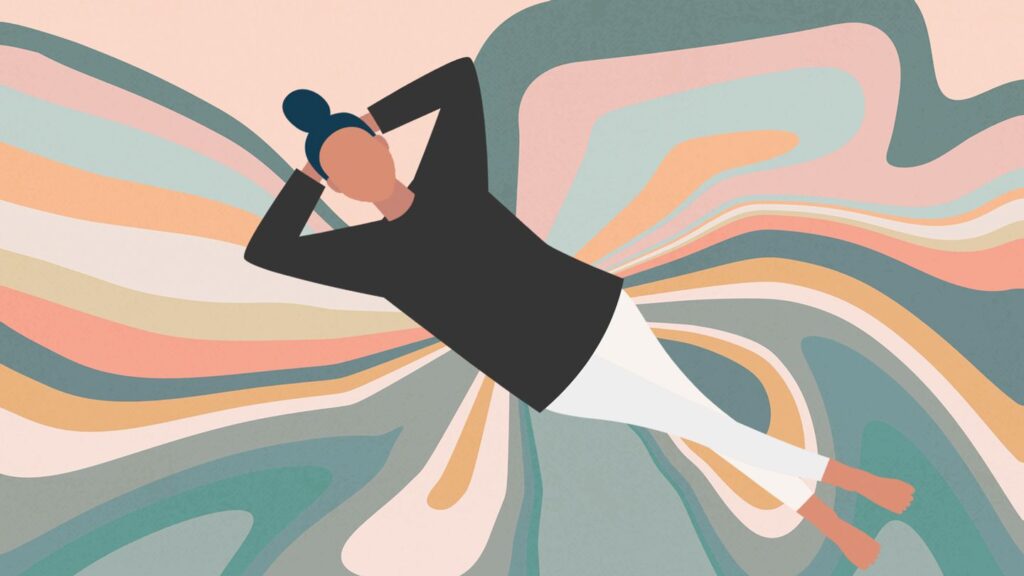Evidence shows certain mushrooms, like psilocybin and lion’s mane, may support ADHD symptoms by improving focus, motivation, and emotional regulation. Both microdosing and macrodosing have potential benefits, especially when combined with proper guidance and integration.
There has been a wave of interest in recent years, more and more people with attention deficit hyperactivity disorder – or ADHD for short – are turning away from the rigid, clinical feel of prescription meds and asking deeper questions about healing.
Can mushrooms offer something different? Something more holistic, and perhaps more sustainable?
For many living with ADHD, the struggle runs deeper than distraction. It’s the constant mental noise, the emotional highs and lows, the sense of always being behind.
Traditional medications like Adderall or Ritalin can offer short-term relief, but they often come with consequences: crashes, flatness, insomnia, or even burnout.
That’s where mushrooms enter the conversation.
In this article, we’ll explore whether mushrooms, psychedelic or not, can help manage ADHD symptoms. We’ll walk through the science of how psilocybin and functional mushrooms like lion’s mane work in the brain, compare microdosing to macro dosing, and highlight what we’ve learned from years of supporting people with ADHD.
You’ll hear real-world insights, explore risks and benefits, and discover whether mushrooms might offer the breakthrough you’ve been looking for.
Why ADHD Is More Than Just “Can’t Sit Still”

ADHD is wildly misunderstood. It’s not just bouncing legs or half-finished projects, it’s a deeply felt experience of being out of sync with the world.
Many of our guests with ADHD describe it like this: “My brain is a race car, but the brakes barely work.” Behind the labels and diagnoses, there’s a very real struggle to regulate thoughts, manage emotions, and follow through on even the simplest of plans.
While every ADHD brain is unique, there are a few key challenges we see again and again:
- Executive Dysfunction: Trouble starting, finishing, or organizing tasks, even ones that truly matter.
- Dopamine Dysregulation: A constant craving for stimulation, novelty, or “the next thing”, paired with deep frustration when motivation vanishes.
- Emotional Reactivity: Intense feelings that seem to come out of nowhere and take hours (or days) to settle.
These internal battles aren’t about willpower. They’re rooted in how the ADHD brain is wired. That’s why most conventional treatments, like Adderall, Vyvanse, or Ritalin, focus on stimulating the brain’s dopamine system.
They aim to “rev up” attention and impulse control by increasing neurotransmitter activity. And yes, for many, these medications can be a game-changer. But others hit a wall.
Why Some People Are Seeking Alternatives
We’ve worked with guests who describe their ADHD meds as both a lifeline and a leash. They’re productive, but disconnected. Focused, but emotionally flat. They’ll say:
“I get things done, but I don’t feel like myself.”
And then there’s the stimulant rollercoaster. The morning burst, the late-day crash. The appetite loss, the sleeplessness, the mounting tolerance. Over time, the cost starts to outweigh the benefits.
That’s when people start looking elsewhere. Not because they’ve given up on healing, but because they want something that feels more grounded.
Mushrooms, especially psilocybin, have started entering that conversation.
People want to know:
- Can mushrooms offer the same cognitive boost as stimulants, without the crash?
- Can they improve motivation, attention, and emotional regulation in a way that feels more natural?
- Can they help me feel like me again?
These are the questions we hear daily. And for many of our guests, the answer isn’t a simple yes or no. It’s more like, yes, with support, with intention, and with the right tools in place.
Let’s dig into what these mushrooms actually do, and why they’re showing promise for ADHD.
Mushroom Types & What They Might Do
Let’s clear something up first: not all mushrooms are psychedelic, but many non-psychedelic mushrooms are neuroactive.
In the world of mushroom healing, we tend to divide them into two categories: psychedelic and functional. Both offer benefits for ADHD, but they work in very different ways.
Psychedelic vs. Functional Mushrooms: What’s the Difference?

At The Buena Vida, we work primarily with psilocybin, the active compound in psychedelic mushrooms. These are the mushrooms that can lead to deep emotional insights, ego dissolution, and lasting shifts in how you perceive the world and yourself. They require intentional use, safe environments, and skillful integration.
Then there are functional mushrooms like lion’s mane, reishi, and cordyceps. These don’t alter consciousness, but they do support brain and body health in a more subtle, long-term way.
Here’s a simple breakdown:
- Psilocybin (psychedelic): Alters perception, boosts neuroplasticity, can disrupt stuck thought loops and emotional patterns.
- Lion’s Mane (functional): Supports memory, learning, and nervous system regeneration. A legal, daily-use mushroom.
- Reishi & Cordyceps (functional): Help regulate energy, reduce inflammation, and support stress resilience, beneficial for the overstimulated ADHD nervous system.
While psilocybin is still considered a controlled substance in most places, functional mushrooms like lion’s mane are widely legal, available online, and even sold in health food stores.
The key takeaway?
Not all mushrooms are mind-altering, but many are brain-altering. And when used wisely, both can support the ADHD journey in different ways.
Psilocybin and ADHD, How It Works on the Brain
We’ve seen firsthand how psilocybin can help people with ADHD feel more focused, present, and emotionally grounded.
Psilocybin works by binding to serotonin receptors and increasing communication across different brain regions. In simpler terms, it quiets the noise of overactive thought loops and gives the brain space to rewire.
- Enhances neuroplasticity: Allows the brain to form new, healthier patterns of thought and behavior.
- May recalibrate dopamine sensitivity: Helping balance the reward-seeking tendencies common in ADHD.
- Disrupts internal restlessness: Eases the constant inner “buzz” many people with ADHD live with.
- Supports executive function: Especially when followed with integration practices like journaling, coaching, and mindfulness.
That last part is essential. Without integration, the benefits of psilocybin tend to fade. But with structure, tools, and guidance, we’ve seen some of the most powerful ADHD breakthroughs emerge from this kind of work.
Lion’s Mane and Cognitive Function
Now let’s talk about a non-psychedelic mushroom that’s quietly become a favorite in our community: lion’s mane.
Lion’s mane is known for its ability to support neural regeneration, it encourages the brain to repair and grow new connections. For those of us with ADHD, who often struggle with memory lapses and scattered focus, this can make a meaningful difference over time.
What we love about lion’s mane:
- It’s legal and safe for daily use in most places.
- It supports working memory, focus, and mental clarity.
- It pairs beautifully with psilocybin, this is called “stacking”, to enhance neurogenesis and integration.
Our guests often begin using lion’s mane weeks before a ceremony and continue afterward to help anchor the insights from their journey.
What’s Better for ADHD, Microdosing or Macrodosing?
If you’re exploring psilocybin mushrooms for ADHD, this is one of the first crossroads you’ll face: microdose or macrodose?
Both paths offer something valuable, but they work very differently, and choosing the right one depends on your goals, your nervous system, and your capacity for integration.
Let’s break them down:
| Dosage Style | What It Means | How It Feels | How It May Help with ADHD |
| Microdosing | Taking a sub-perceptual dose every few days | Subtle shifts in clarity, mood, focus | Improved task initiation, calm, energy regulation |
| Microdosing | A full psychedelic journey (1–3g+) | Intense, immersive, potentially life-changing | Insight into root patterns, emotional breakthroughs |
People often ask us: “Have guests found more benefit in microdosing or in full journeys?” And the honest answer is: both, but in different ways.
Microdosing Benefits (and Drawbacks)
Microdosing is about subtle consistency. Think of it like gently nudging the brain into a better groove, without the intensity of a full trip. You won’t be “tripping,” but you might feel a bit lighter, more emotionally balanced, or more engaged with your work.
Here’s what we’ve seen it support most in ADHD guests:
- Improved task initiation
- More stable emotional baseline
- Less reactivity and overwhelm
- Increased motivation without anxiety spikes
And as psilocybin focuses on the serotonin side of the brain, rather than the dopamine side as traditional ADHD medicines do, microdosing could be an avenue to explore for those who have never had much success with stimulants such as Adderall or Ritalin.
Macro Dosing Insights from Retreats
Macro dosing , taking the dosage required for a full psilocybin experiance, on the other hand, is not subtle. It’s deep. It’s immersive. And for many people with ADHD who’ve felt stuck in the same thought loops or behavior cycles for years, it can be the reset they didn’t know they needed.
At The Buena Vida, we’ve guided countless guests through these journeys, and here’s what we hear over and over:
“That journey helped me see the why behind my restlessness. It wasn’t just ADHD, it was pain I hadn’t even named.”
Macro dosing can bring unconscious patterns to the surface. For those with ADHD, this often includes childhood shame, social rejection, or internalized failure. When held in a safe, supportive setting, these realizations don’t have to be destabilizing, they can be freeing.
What macro dosing may support:
- Emotional breakthroughs and self-forgiveness
- Clarity on root causes of behaviors
- Increased self-compassion
- New motivation aligned with deeper purpose
But we never recommend diving into a high-dose journey without preparation. The risks are real:
- Derealization or disorientation
- Emotional dysregulation post-journey
- Unprocessed trauma resurfacing
Guests with ADHD often need extra integration time after a journey. The emotional “afterglow” can linger longer, and without structure or support, it’s easy to get lost in it.
That’s why our retreats are designed with extended support before and after the journey. The real medicine? It’s not just what happens in the ceremony, it’s what you do with it afterward.
What Mushrooms Might Help With, And What They Don’t
Mushrooms are not a cure-all, but for many of our guests, they’ve offered a level of healing and clarity that traditional treatments never touched.
When used with intention and integration, certain mushrooms, particularly psilocybin and lion’s mane, can gently shift how people with ADHD experience the world, their thoughts, and themselves. And while no two journeys are alike, we’ve seen consistent patterns in the kinds of symptoms that respond most positively.
Symptoms That Mushrooms May Improve
Here’s what mushrooms may support, based on a blend of emerging science, client feedback, and years of direct facilitation:
- Focus and sustained attention: Psilocybin may help reduce mental noise, while lion’s mane supports long-term cognitive function.
- Emotional regulation and resilience: Mushrooms often create space between a feeling and a reaction, helping those with ADHD to pause instead of spiraling.
- Time awareness and planning: Guests report a greater ability to feel and manage time, crucial for ADHD brains prone to time blindness.
- Motivation and internal drive: By shifting out of shame and into meaning, mushrooms can reignite purpose-based action.
- Self-compassion and reduced shame spiral: So many people dealing with ADHD carry years of “Why can’t I just…?” Mushrooms help them reframe that story.
- Sensory overwhelm and anxiety: A recalibrated nervous system = less reactivity to lights, sounds, and social pressure.
When mushrooms are integrated into a structured, supportive healing journey, these shifts can be profound, and long-lasting.
Symptoms That May Not Respond Well (or May Worsen)
That said, mushrooms are not risk-free, especially for neurodivergent minds.
Some people may experience adverse effects, particularly when using mushrooms without guidance, preparation, or a clear understanding of their mental health history.
Here’s where we recommend extra caution:
- Derealization or dissociation: If you’ve struggled with disconnection from reality, mushrooms can sometimes intensify that, especially in high doses.
- Mania, racing thoughts, or overstimulation: ADHD already creates an overactive nervous system, and some may find that even small doses are too activating.
- Impulsive behavior or poor judgment: Without a container or intention, psychedelics can amplify risky decision-making in already impulsive individuals.
Risks, Questions & Concerns
Let’s talk about the side of the conversation that rarely gets enough airtime, the risks.
As powerful as mushrooms can be, they’re not a fit for everyone. And when it comes to ADHD, especially when layered with trauma, medication, or emotional sensitivity, we need to move with care.
What Are the Real Risks of Using Mushrooms for ADHD?
We’ve worked with hundreds of neurodivergent guests, and if there’s one thing we’ve learned, it’s this: mushrooms amplify what’s already present. That can lead to breakthroughs, but it can also bring up a lot if you’re not prepared.
Here’s where the biggest risks tend to show up:
- Mental Health History: Mushrooms aren’t recommended for those with active bipolar disorder, untreated psychosis, or unresolved trauma without support. They can destabilize more than they heal in those cases.
- Medication Interactions: Psilocybin interacts with certain medications. Stimulants like Adderall or Vyvanse can increase overstimulation. SSRIs may dampen the effects or, worse, trigger serotonin overload. Always consult with a qualified professional before combining.
- Legal Risks: Psilocybin is still a controlled substance in many places. Decriminalization and clinical access are growing, but legal status varies widely.
- Emotional Turbulence Post-Journey: A common concern we hear:
That’s why at The Buena Vida, we build safe containers with licensed mental health professionals, somatic support, and post-journey check-ins.
Can Mushrooms Replace ADHD Meds?
This is the million-dollar question.
For some guests, mushrooms have offered the kind of clarity, emotional regulation, and focus that felt more powerful than years on medication. But for others, meds still serve an essential role, and mushrooms work best as a complement, not a substitute.
From what we’ve seen, the most successful shifts happen when mushrooms are part of a wider strategy, which might include:
- Therapy or coaching
- Digital ADHD tools (timers, planners, habit trackers)
- Somatic practices (yoga, breathwork, grounding)
- Psychedelic integration support
The goal isn’t to “fix” your brain. It’s to build a relationship with it, one rooted in understanding, compassion, and sustainable practices.
So, can mushrooms replace ADHD meds?
Maybe. For some. But more often, they help you build a deeper toolkit, and reconnect with the parts of yourself that medication alone can’t reach.
Integration is Everything

If there’s one thing I wish every person exploring mushrooms for ADHD could understand, it’s this:
The ceremony isn’t the medicine. What you do afterward is.
Mushrooms can show you what’s possible. They can spark insight, calm the noise, and awaken parts of you that’ve been dormant for years. But without a plan to bring those insights back into your daily life, the magic fades. Fast.
That’s why we say integration isn’t optional, it’s the whole point.
Why What Happens After the Trip Matters Most
ADHD minds are beautiful, fast, and creative, but they also struggle with structure, memory, and follow-through. That’s why we build custom post-journey support plans for our guests, tools that help them translate insight into real-life change.
- Digital tools. Use habit trackers, ADHD-friendly planners, or time-blocking apps to stay grounded in new routines.
- Grounding practices. Start the day with breathwork, meditation, or a short walk to anchor your nervous system.
- Emotional literacy training. Learn to name what you’re feeling. Mushrooms unlock emotional depth.
- Daily intention-setting. Writing and reviewing your intentions keeps your post-journey clarity alive and focused.
We’ve noticed something profound: ADHD guests often need more time to stabilize after a journey, not because they’re broken, but because their nervous systems are more sensitive to change. And that’s okay. With the right support, the transformation sticks.
Tips for Safe, Supported Use
If you’re starting this path, take your time. Mushrooms aren’t a shortcut, they’re a doorway. How you step through matters.
Here’s what we always recommend:
- Start low, go slow. Especially with microdosing. Every brain responds differently, and more isn’t better.
- Work with guides who understand ADHD. Whether it’s a retreat, a coach, or a therapist, find someone who gets your wiring.
- Take breaks. Give your brain space to breathe. Microdosing daily without rest can flatten the very magic you’re trying to access.
- Journal everything. Track your moods, insights, and questions. ADHD minds can forget even the most powerful moments.
- Don’t expect a miracle cure. Mushrooms are powerful, but they’re not the whole puzzle. Think of them as a catalyst, not the entire solution.
Can Mushrooms Help With ADHD?
They might. Especially when used with the right dose, the right support, and the right expectations. We’ve seen them offer real, lasting changes in focus, motivation, emotional regulation, and self-compassion.
But let’s be clear: mushrooms aren’t a replacement for structure, routine, or the hard work of building new habits. They’re not magic pills. They’re mirrors, reflecting back what’s ready to shift, if you’re willing to do the integration.
At The Buena Vida, we’ve had the honor of witnessing people suffering for years with ADHD rediscover themselves, not as broken or scattered, but as beautifully wired for depth, creativity, and insight.
And yes, mushrooms often help open that door. But it’s how you walk through it that creates real healing.
If you’ve read this far, you’re probably not just looking for a new supplement or productivity hack. You’re looking for relief. For reconnection. For something that brings you home to yourself.
We’d be honored to walk with you.


